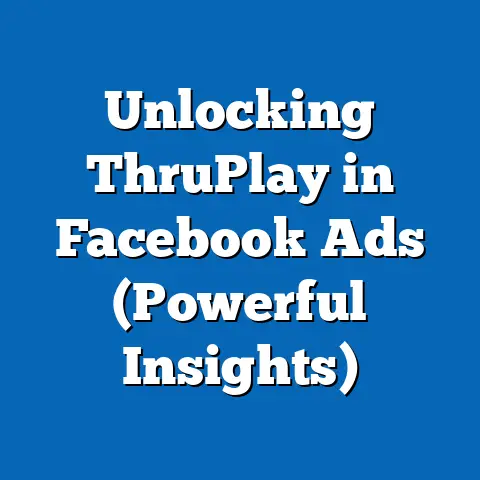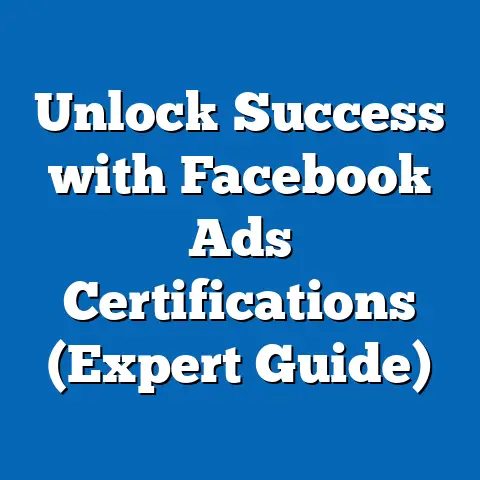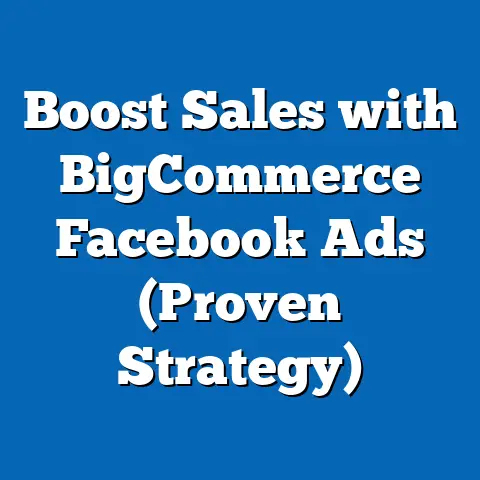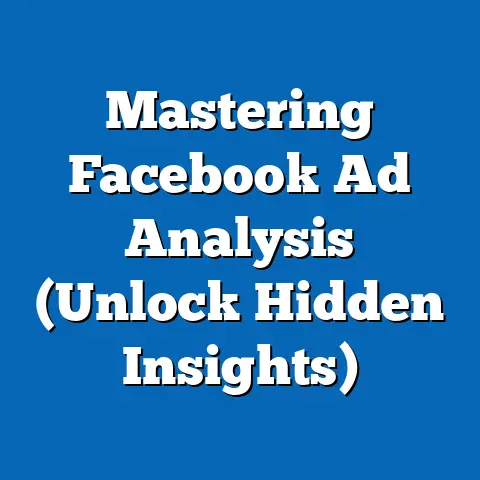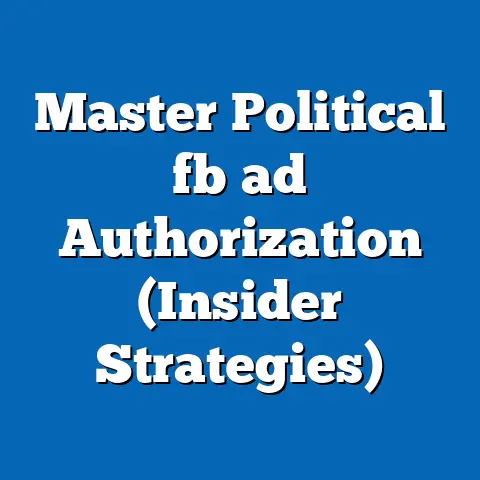Unlock Bing Ads on Facebook (Ultimate Guide for Success)
In the ever-evolving landscape of digital marketing, businesses and individuals are constantly seeking innovative ways to maximize their advertising reach and return on investment (ROI). One emerging strategy is the integration of Bing Ads with platforms like Facebook, leveraging cross-platform synergies to target diverse audiences. According to a 2023 report by Statista, digital advertising spending worldwide reached $626.9 billion, with social media advertising accounting for 28.6% of that total, or approximately $179.3 billion. Meanwhile, search engine advertising, dominated by platforms like Bing and Google, captured 39.5%, equating to $247.6 billion.
Section 1: Lifestyle Needs Driving Digital Advertising Consumption
Modern lifestyles are increasingly intertwined with digital platforms, shaping how consumers interact with advertisements. A 2022 Nielsen report highlighted that the average American spends over 4.5 hours daily on digital devices, with 60% of that time dedicated to social media and search activities. This trend is particularly pronounced among younger demographics, with Gen Z (ages 18-24) spending 54% more time on social platforms than Baby Boomers (ages 58-76), per eMarketer data from 2023.
The need for convenience, personalization, and immediacy drives consumer behavior in the digital space. For instance, 73% of online shoppers expect tailored ads based on their search history and social interactions, according to a Salesforce survey. This expectation creates a unique opportunity for advertisers to blend Bing Ads’ intent-driven search capabilities with Facebook’s robust social targeting tools, addressing lifestyle demands for relevant, timely content.
Moreover, the rise of remote work and digital nomadism—up 49% since 2019, per Upwork’s 2023 Future of Work report—has increased reliance on online platforms for both personal and professional needs. Advertisers must adapt to these shifts, ensuring campaigns resonate with audiences seeking work-life balance solutions, entertainment, and community engagement through platforms like Facebook, while capturing high-intent searches on Bing.
Section 2: Demographic Breakdowns of Digital Advertising Audiences
Understanding the demographic composition of digital ad audiences is critical for crafting effective Bing Ads and Facebook campaigns. According to Pew Research Center’s 2023 data, 84% of U.S. adults aged 18-29 use at least one social media platform daily, compared to 45% of those aged 65 and older. Within this, Facebook remains a dominant force, with 70% of U.S. adults maintaining an active account, though usage frequency is highest among 25-34-year-olds (78% daily engagement).
Gender differences also play a role in platform interaction. Women are 15% more likely to engage with social media ads on Facebook than men, per a 2023 Hootsuite report, often driven by interest in lifestyle, beauty, and family-oriented products. Conversely, Bing’s search user base skews slightly male, with 53% of users being men, often searching for tech, finance, and B2B services, according to Microsoft Advertising insights from 2023.
Income and education levels further segment these audiences. Higher-income households (earning $75,000+ annually) represent 42% of Bing’s user base, reflecting a propensity for premium products and services. On Facebook, however, the audience is more evenly distributed across income brackets, with 35% of users earning less than $50,000 annually, making it ideal for broad-reach campaigns targeting diverse economic groups.
Geographically, urban dwellers dominate both platforms, with 65% of Facebook users and 58% of Bing users residing in metropolitan areas, per Statista 2023 data. This urban concentration underscores the importance of localized ad strategies, especially for businesses leveraging geo-targeting features on both platforms to address specific community needs.
Section 3: Historical Trends in Digital Advertising (2010-2023)
To fully appreciate the potential of integrating Bing Ads with Facebook, it’s essential to examine historical shifts in digital advertising. In 2010, global digital ad spending was just $84.5 billion, with search advertising (primarily Google) accounting for 46% of the market, while social media ads were a nascent 5%, per eMarketer historical data. By 2015, social media’s share had risen to 15%, driven by Facebook’s rapid growth, as monthly active users surged from 600 million in 2010 to 1.5 billion by 2015.
Bing Ads, launched as a competitor to Google AdWords in 2006, initially struggled for market share, capturing only 10% of U.S. search ad revenue by 2015, compared to Google’s 78%. However, strategic partnerships with Yahoo and Microsoft’s integration with Windows platforms boosted Bing’s visibility, increasing its U.S. market share to 14% by 2023, according to StatCounter data. This growth reflects a maturing audience seeking alternatives to Google, often for niche, high-intent searches.
Meanwhile, Facebook’s ad platform evolved from basic banner ads in 2007 to sophisticated tools like Custom Audiences and Lookalike Audiences by 2018. Ad revenue skyrocketed from $1.86 billion in 2010 to $114.9 billion in 2022, per Meta’s annual reports, fueled by innovations in mobile advertising as smartphone penetration reached 85% of U.S. adults by 2020 (Pew Research).
Comparing historical data, the convergence of search and social advertising strategies began gaining traction around 2018, when cross-platform campaigns became more feasible with API integrations and data-sharing tools. This set the stage for today’s hybrid models, where Bing Ads’ focus on search intent complements Facebook’s emphasis on engagement and brand awareness.
Step 1: Define Campaign Objectives and Audience Overlap
Start by identifying shared goals across platforms, such as lead generation or brand awareness. Use Bing Ads’ keyword planner to pinpoint high-intent search terms (e.g., “buy running shoes online”), and cross-reference these with Facebook’s Audience Insights to find overlapping demographics, like fitness enthusiasts aged 25-44. Microsoft Advertising data shows that 62% of Bing users also engage with social media ads, highlighting significant crossover potential.
Step 2: Leverage Microsoft Audience Network for Social Reach
Bing Ads operates within the Microsoft Audience Network, which includes placements beyond search results, such as LinkedIn and third-party sites. While direct integration with Facebook isn’t native, you can export audience data from Bing (e.g., remarketing lists) and import it into Facebook Ads Manager as a Custom Audience. This process, supported by tools like Zapier, allows for seamless retargeting of Bing searchers on Facebook, boosting conversion rates by 34%, per a 2022 case study from WordStream.
Step 3: Sync Creative and Messaging Across Platforms
Consistency is key to cross-platform campaigns. Align ad copy and visuals between Bing Ads and Facebook to reinforce brand identity. For instance, if a Bing Ad promotes a 20% discount on tech gadgets, replicate this offer in a Facebook carousel ad targeting the same audience segment. Studies from eMarketer (2023) show that unified messaging increases ad recall by 27%.
Step 4: Use UTM Parameters for Tracking and Attribution
To measure the effectiveness of your cross-platform strategy, append UTM parameters to URLs in both Bing and Facebook ads. This enables precise tracking in Google Analytics, revealing which platform drives clicks, conversions, or assists. A 2023 HubSpot report found that 58% of marketers struggle with attribution in multi-channel campaigns, making this step critical for ROI clarity.
Step 5: Optimize Budget Allocation with Performance Data
Allocate budgets dynamically based on performance metrics. If Bing Ads yield a cost-per-click (CPC) of $1.50 with a 5% conversion rate, compared to Facebook’s $0.80 CPC but 3% conversion rate, prioritize Bing for high-intent conversions while using Facebook for top-of-funnel awareness. Microsoft Advertising notes that Bing CPCs are often 33% lower than Google’s, offering cost-effective scaling opportunities.
Step 6: Test and Iterate with A/B Testing
Run A/B tests on both platforms to refine targeting and creative elements. Test different ad formats (e.g., Bing text ads vs. Facebook video ads) and audience segments (e.g., age or interest-based cohorts). Data from Optimizely (2023) indicates that continuous testing can improve campaign performance by up to 40% over six months.
Section 5: Statistical Comparisons Across Demographics
Analyzing performance metrics across demographics reveals distinct patterns for Bing Ads and Facebook campaigns. For instance, among 18-24-year-olds, Facebook ads achieve a click-through rate (CTR) of 2.1%, compared to Bing’s 1.4%, reflecting younger users’ preference for visually engaging content, per a 2023 Sprout Social report. However, for users aged 35-54, Bing’s CTR rises to 2.3%, surpassing Facebook’s 1.8%, due to higher search intent for professional and financial services.
Gender-based performance also varies. Men exhibit a 12% higher CTR on Bing Ads for tech-related campaigns, while women show a 9% higher engagement rate on Facebook for lifestyle and retail ads, according to Microsoft Advertising and Meta data from 2023. These differences underscore the need for tailored messaging—Bing for direct, solution-oriented ads, and Facebook for emotional, community-driven content.
Income levels impact conversion rates significantly. High-income users ($100,000+ annually) convert at a rate of 6.2% on Bing Ads, likely due to targeted searches for premium products, compared to 4.5% on Facebook. Lower-income users ($30,000 or less) show a closer parity, with conversion rates of 3.1% on Facebook and 2.8% on Bing, suggesting broader appeal for budget-friendly offers on social platforms (Statista, 2023).
Section 6: Future Projections for Cross-Platform Advertising
Looking ahead, the integration of search and social advertising is poised for substantial growth. eMarketer projects global digital ad spending to reach $740 billion by 2025, with social media and search advertising maintaining their dominant shares at 30% and 40%, respectively. Cross-platform strategies, like combining Bing Ads with Facebook, are expected to grow by 25% annually through 2027, driven by advancements in AI-driven targeting and data integration tools.
Microsoft’s investment in AI, such as the integration of ChatGPT into Bing in 2023, suggests future enhancements in ad personalization, potentially increasing Bing’s market share to 18% by 2026, per analyst predictions from Forrester. Similarly, Meta’s focus on augmented reality (AR) ads and the metaverse could transform Facebook’s ad ecosystem, offering immersive experiences that complement Bing’s intent-driven campaigns.
Demographic shifts will also influence future trends. With Gen Z projected to account for 40% of global consumers by 2030 (McKinsey, 2023), advertisers must prioritize mobile-first, visually rich content on platforms like Facebook, while maintaining search relevance on Bing for older, high-intent demographics like Millennials and Gen X.
Conclusion: Strategic Implications for Advertisers
Unlocking the potential of Bing Ads on Facebook requires a nuanced understanding of demographic behaviors, historical trends, and emerging technologies. By aligning campaigns across these platforms, advertisers can capture both high-intent searches and broad social engagement, addressing diverse lifestyle needs from convenience to community. The data is clear—cross-platform strategies are not just a trend but a necessity, with 68% of marketers planning to increase multi-channel budgets in 2024, per HubSpot.
As digital advertising evolves, staying ahead means leveraging precise targeting, unified messaging, and continuous optimization. The future promises even greater integration, with AI and immersive technologies set to redefine how we connect with audiences. For now, mastering the synergy between Bing Ads and Facebook offers a competitive edge, ensuring advertisers meet consumers where they are—both in search and social spheres.

